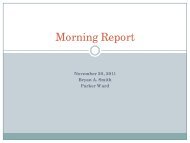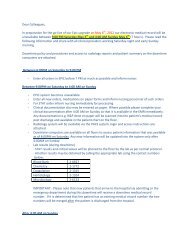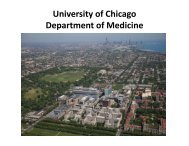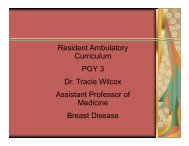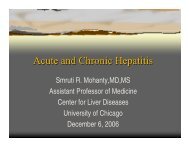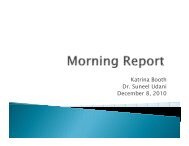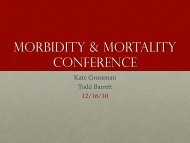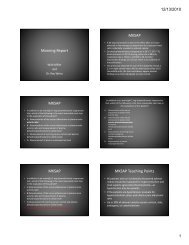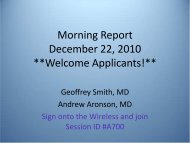Cards: AV Endocarditis presenting as back pain
Cards: AV Endocarditis presenting as back pain
Cards: AV Endocarditis presenting as back pain
You also want an ePaper? Increase the reach of your titles
YUMPU automatically turns print PDFs into web optimized ePapers that Google loves.
DON’T FORGET TO<br />
SWIPE!!!
Morning Report<br />
April 10th, 2012<br />
Roderick Deaño<br />
Jack Ende, MD<br />
Parker Ward, MD
MKSAP<br />
A 51-year-old woman is evaluated during a routine<br />
physical examination. She h<strong>as</strong> no history of hypertension<br />
and h<strong>as</strong> never used tobacco. There is no family history<br />
of heart dise<strong>as</strong>e. Her only medication is daily oral<br />
conjugated estrogens combined with<br />
medroxyprogesterone acetate for intolerable hot flushes.<br />
Physical examination is normal. BMI is 31. A f<strong>as</strong>ting lipid<br />
panel is obtained with the following results: total<br />
cholesterol, 218 mg/dL (5.65 mmol/L); HDL cholesterol,<br />
42 mg/dL (1.09 mmol/L); LDL cholesterol, 128 mg/dL<br />
(3.32 mmol/L); triglycerides, 240 mg/dL (2.71 mmol/L).
Which of the following is the most<br />
appropriate next step in the<br />
management of this patient?<br />
A. Calculate<br />
Framingham risk score<br />
B. Calculate non-HDL<br />
cholesterol level<br />
C. Prescribe<br />
atorv<strong>as</strong>tatin<br />
D. Prescribe<br />
gemfibrozil<br />
0% 0% 0% 0%<br />
1 2 3 4
The most appropriate management option for this patient is to calculate her non-HDL cholesterol<br />
level. This patient h<strong>as</strong> a high triglyceride level (>200 mg/dL [2.26 mmol/L]). According to the Adult<br />
Treatment Panel III guidelines, the next step in the management of a patient with a triglyceride<br />
level between 200 mg/dL and 500 mg/dL (2.26 and 5.65 mmol/L) is to calculate non-HDL<br />
cholesterol (total cholesterol minus HDL cholesterol) to determine whether triglyceride-lowering<br />
medication is indicated. In addition, reversible causes of hypertriglyceridemia should be sought.<br />
These include excessive alcohol intake, obesity, high carbohydrate intake, physical inactivity, type<br />
2 diabetes mellitus, renal dise<strong>as</strong>e, and certain medications (corticosteroids, β-blockers, estrogens,<br />
and prote<strong>as</strong>e inhibitors).<br />
LDL cholesterol goal is b<strong>as</strong>ed on the presence or absence of five major risk factors (smoking,<br />
hypertension, older age, low HDL cholesterol, family history of premature coronary artery<br />
dise<strong>as</strong>e). This patient does not have any of these risk factors; therefore, her LDL cholesterol goal<br />
is 160 mg/dL (4.14 mmol/L), and she does not need a statin.<br />
The second therapeutic target is the non-HDL cholesterol. The non-HDL cholesterol goal is set at<br />
the LDL goal plus 30 mg/dL (0.78 mmol/L); therefore, her non-HDL cholesterol goal is 190 mg/dL<br />
(4.92 mmol/L). This patient’s non-HDL cholesterol level is 176 mg/dL (4.56 mmol/L); therefore,<br />
triglyceride-lowering medication (gemfibrozil or other fibrate medication) is not indicated.<br />
Triglyceride-lowering medication should be considered in patients with a personal or family history<br />
of premature coronary artery dise<strong>as</strong>e regardless of non-HDL cholesterol level. The patient<br />
presented h<strong>as</strong> no family history of premature coronary artery dise<strong>as</strong>e.<br />
The Framingham risk score, used to further stratify some patients with elevated LDL cholesterol,<br />
does not have to be calculated in this patient because her LDL cholesterol of 128 mg/dL (3.32<br />
mmol/L) is below the goal of 160 mg/dL (4.14 mmol/L). Calculating the Framingham risk score is<br />
most helpful in making management decisions when patients have an LDL cholesterol level above<br />
their target goal.
61yom presents to your PCP<br />
clinic:<br />
“Doc, I have this <strong>pain</strong> in my<br />
lower <strong>back</strong>.”
Lower Back Pain – Persistent, non-radiating;<br />
happening for two months, non-exertional, no<br />
trauma to area, no distal paresthesi<strong>as</strong>,<br />
incontinence or lower extremity weakness. Not<br />
relieved with lying down or OTC NSAIDS. No<br />
F/C, no weight loss<br />
L UE Weakness – starting 3 days ago while<br />
changing his clothes, w no par<strong>as</strong>thesi<strong>as</strong> or<br />
decre<strong>as</strong>e sensation<br />
Went to OSH ED, CT Head w<strong>as</strong> negative<br />
Presents bc LUE weakness still persists
PMH:<br />
ESRD x 10 yrs – MWF HD;<br />
secondary to HTN<br />
R Femoral Tunneled<br />
catheter<br />
HTN<br />
PE – diagnosed OSH 9<br />
months ago on coumadin<br />
(unclear if had<br />
hypercoagulable w/u)<br />
? CVA (per history) approx<br />
20 yrs ago w resolved R<br />
sided weakness<br />
OSA on CPAP<br />
H&P<br />
NKDA<br />
MEDS: Albuterol prn; Renvela<br />
TID; Nifedipine 60 mg qday;<br />
diazepam 5mg qhs; vit D;<br />
coumadin<br />
Social Hx: former security<br />
guard; separated w 5 healthy<br />
children; former crack use<br />
(smoked); l<strong>as</strong>t use 2 yrs ago;<br />
no IVDU; never smoker; quit<br />
ETOH, used to drink 1 pint<br />
every other week w three<br />
friends<br />
FH: non-contributory
Differential?
focused history and physical examination to help place patients with<br />
low <strong>back</strong> <strong>pain</strong> into 1 of 3 broad categories:<br />
nonspecific low <strong>back</strong> <strong>pain</strong>,<br />
<strong>back</strong> <strong>pain</strong> potentially <strong>as</strong>sociated with radiculopathy or spinal<br />
stenosis,<br />
or <strong>back</strong> <strong>pain</strong> potentially <strong>as</strong>sociated with another specific spinal<br />
cause.<br />
no routine imaging or other diagnostic tests in patients with<br />
nonspecific low <strong>back</strong> <strong>pain</strong><br />
diagnostic imaging for low <strong>back</strong> <strong>pain</strong> when severe or progressive<br />
neurologic deficits are present or when serious underlying conditions<br />
are suspected<br />
evaluate patients with persistent low <strong>back</strong> <strong>pain</strong> and signs or<br />
symptoms of radiculopathy or spinal stenosis with MRI or CT only if<br />
candidates for surgery or epidural
Physical Exam<br />
VS: AF (36), HR 89 BP 101/40 RR 20 94% on 2L<br />
GEN: AAM, looks appropriate age, no acute distress<br />
HEENT: NC/AT EOMI PERRL, Anicteric clear O/P; no<br />
supraclavicular/axillary LAD, no thyromegaly<br />
Chest: CTAB, No W/R<br />
CV: RRR, Nl S1, S2, Di<strong>as</strong>tolic murmur; JVP 12cm above RA, 2+<br />
radial/dp pulses, warm extremities w good cap refill. Nl carotid upstroke<br />
Abd: soft obese, NTND, +BS<br />
Ext: No LE Edema; warm extremities; erythema around the R femoral<br />
catheter<br />
Neuro: CNII-XII intact, A&O x3; no focal deficits; normal sensation; no T<br />
in the cervical/thoracic/lumbar spine<br />
Musk: 5/5 Strength LE BL; 4/5 LUE; 5/5 RUE;<br />
Skin: no r<strong>as</strong>hes; no track marks in UE’s.
What initial diagnostics<br />
to you want to order?
CT Head<br />
Small focus of SAH isolated in R central<br />
sulcus w/o evidence of parenchymal<br />
edema<br />
Minimal small vessel dise<strong>as</strong>e of<br />
indeterminate age<br />
Pt admitted for SAH, in setting of<br />
therapeutic INR
5.1<br />
11.3<br />
Lab Tests<br />
156<br />
N 78; no bands<br />
7.7 3.5<br />
0.3 0.2/0.2<br />
15 7<br />
128<br />
138 93 23<br />
4.0 30 6.7 84<br />
INR 2.4<br />
BC’s Pending<br />
HIV pending<br />
UA neg<br />
Utox neg<br />
8.9<br />
2.1<br />
4.3
Chest Xray
TTE
TTE<br />
LV: nl size; mild LVH; nl EJF (60-65%); No<br />
WMA<br />
RV: moderately dilated; moderately<br />
reduced<br />
LA: mildly dilated and dilated IVC: nl RA<br />
Trace MR; trace TR; moderate AR<br />
Estimated RV: 53.5 + RA
Course Continues<br />
Admitted to Neuro ICU for SAH<br />
FFP Given to reverse INR<br />
L Femoral quinton exchanged over a wire for another HD<br />
Catheter, cultures sent<br />
BC from first day positive 2/2 for CONS (2 bottles) and<br />
Staph Hominus (1/2); HIV neg<br />
Pt h<strong>as</strong> incre<strong>as</strong>ed O2 requirement and now requiring<br />
intermittent BiPap for incre<strong>as</strong>ed WOB<br />
ABG 7.35/44/85/95% (on NRB 100%)<br />
Pt started on empiric Vanc/Cefepime<br />
CRP 124
Next Management Steps?
MRI Lumbar/Thoracic<br />
Abnl incre<strong>as</strong>ed signal intensity of<br />
intervertebral disk spaces @ T8-9 w<br />
<strong>as</strong>sociated adjacent marrow signal abnl of<br />
vertebral bodies raising concern for<br />
discitis/osteo; incre<strong>as</strong>ed signal intensity of<br />
intervertebral disc @ T7-T8
MRI Head<br />
Focus of restricted diffusion on R<br />
precentral gyrus of frontal lobe <strong>as</strong>sociated<br />
w parenchymal and subarachnoid<br />
hemorrhage; v<strong>as</strong>ogenic edema<br />
surrounding this region raises possibility of<br />
infected embolic stroke.
TEE
LV: nl performance<br />
TEE<br />
Atria: no m<strong>as</strong>s or thrombus<br />
Mild MR w moderate mitral annular<br />
calcification<br />
Trace TR<br />
Moderate-sized vegetation/m<strong>as</strong>s on <strong>AV</strong> 1<br />
1.2 cm pedunculated m<strong>as</strong>s on aortic<br />
leaflet c/w vegetation; severe AR
ECG
ECG<br />
Mobitz Type II <strong>AV</strong> Block and Sinus<br />
Bradycardia<br />
*Pt w<strong>as</strong> actually in Normal Sinus
Clinical Summary<br />
Pt h<strong>as</strong> likely mycotic aneurysm causing<br />
SAH, <strong>Endocarditis</strong> with Acute AR; discitis<br />
and osteomyelitis<br />
Pt is SOB with incre<strong>as</strong>ing oxygen<br />
requirement<br />
Now transferred to medicine service<br />
(CCU) for better coordination of medical<br />
care<br />
Next Management steps?
10-40% of patients with left sided endocarditis have<br />
neurologic complications<br />
Embolic CVA, ruptured mycotic aneurysm, TIA, meningitis, brain<br />
abscess, seizure<br />
Safety of cardiopulmonary byp<strong>as</strong>s w acute neurologic<br />
deficits (such <strong>as</strong> hemorrhage) and active endocarditis<br />
Reviewed charts and found 247 patients that underwent<br />
repair of valve for endocarditis<br />
34 had pre-operative neurologic deficits<br />
More neurologic deficits in pts who underwent surgery<br />
within 11 days of acute neurologic event<br />
Many of those patients were hemodynamically unstable and<br />
needed to go urgently
Clinical Management<br />
How would you manage the patient in the<br />
meantime: acute AR and endocarditis?<br />
What are some of the important things to<br />
watch for re: endocarditis?
Acute AR<br />
Circulation 2009, 119:3232-3241
Acute AR<br />
Chronic regurgitation of <strong>AV</strong> affords time for the ventricle<br />
to dilate to accommodate the regurgitant volume to<br />
maintain forward SV and CO<br />
LV does not compensate; initial compensatory<br />
tachycardia may preserve cardiac output initially, but<br />
eventually hypotension, organ failure, and other<br />
evidence of cardiogenic shock will develop.<br />
Pulmonary capillary wedge pressure incre<strong>as</strong>es abruptly and<br />
pulmonary edema develops<br />
Present with dyspnea, hemodynamic instability, and<br />
symptoms of shock, including weakness, dizziness, and<br />
AMS<br />
Circulation 2009, 119:3232-3241
Acute AR - Treatment<br />
Surgical Emergency<br />
Medically Stabilize until surgery<br />
Decre<strong>as</strong>e LVEDP<br />
Consider afterload reduction if BP can tolerate<br />
to improve forward flow<br />
Consider inotropic support to augment CO<br />
Griffin, Topol, 2009; Circulation 2009, 119:3232-3241
<strong>Endocarditis</strong> – Duke Criteria<br />
Circulation 2005, 111:e394-e434
<strong>Endocarditis</strong> - Complications<br />
CHF<br />
Embolization<br />
Higher rates with left sided vegetations; greater than 1cm in size<br />
Peri-annular extension of infection<br />
Occurs in the weakest portion of the annulus in native valve IE,<br />
near the membranous septum and <strong>AV</strong> Node<br />
Daily EKG for monitoring<br />
Splenic abscess<br />
Mycotic aneurysms<br />
septic embolization of vegetations to the arterial v<strong>as</strong>a v<strong>as</strong>orum<br />
or the intraluminal space, with subsequent spread of infection<br />
through the intima and outward through the vessel wall.<br />
Circulation 2005, 111:e394-e434
Hospital Course<br />
SCUF/CVVH for more fluid off<br />
Started v<strong>as</strong>odilators for afterload <strong>as</strong> BP<br />
tolerated<br />
Cath – non-obstructive Dise<strong>as</strong>e<br />
Repeat CTA head– no evidence of any<br />
aneurysm
Surgical Repair
Further Hospital Course<br />
Successful surgery with replacement with<br />
Tissue Aortic Valve<br />
Subsequent CTA Head negative for<br />
aneurysm<br />
CT PE positive for multiple segmental PE<br />
– started on heparin (and eventually<br />
coumadin) after cleared by Neuro<br />
Discharged on IV Vanc for 8 weeks to<br />
rehab
Take Home Points<br />
Low Back Pain workup<br />
Management of Acute AR<br />
Complications of <strong>Endocarditis</strong>
Thank you!
References<br />
1. Baddour, Wilson, et al. “Infective <strong>Endocarditis</strong>.” Circulation 2005,<br />
111:e394-e434<br />
2. Chou, R.; Q<strong>as</strong>em, Amir.; Vincenza, S, et al. “Diagnosis and Treatment of<br />
Low Back Pain: A Joint Clinical Practice Guideline from the American<br />
College of Physicians and the American Pain Society“. Ann Intern Med.<br />
2007;147:478-491<br />
3. Enriquez-Sarano M, Tajik AJ. “Clinical practice. Aortic regurgitation.” N<br />
Engl J Med. 2004 Oct 7;351(15):1539-46<br />
4. Gillinov AM, Shah RV, Curtis WE, Stuart RS, Cameron DE, Baumgartner<br />
WA, Greene PS. “Valve replacement in patients with endocarditis and<br />
acute neurologic deficit.” Ann Thorac Surg. 1996 Apr;61(4):1125-9<br />
5. Griffin, Topol, et al. Manual of Cardiov<strong>as</strong>cular Medicine. Third Edition.<br />
Wolters Kluwer. 2009<br />
6. Stout KK, Verrier ED. “Acute valvular regurgitation. Circulation. 2009 Jun<br />
30;119(25):3232-41. Review.<br />
7. UTD – “Low <strong>back</strong> <strong>pain</strong>.”
ADDENDUM
AR Table
DON’T FORGET TO<br />
SWIPE!!!



